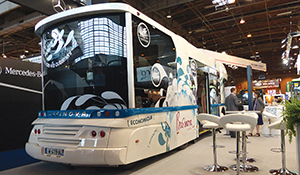
By Doug Jack
The Transports Publics Exhibition takes place in Paris every two years at the Porte de Versailles Center. The event in June was billed as the European Mobility Exhibition. In the United Kingdom the term “mobility” has a narrower meaning of accessibility to public transport by people with disabilities. While the French definition of mobility includes accessibility, the French use the tern in the wider sense to describe the capability to move from A to B by any means other than personal cars — as the European Mobility Exhibition demonstrated.
—————————————————————————————————————————————
YOU MIGHT ALSO LIKE:
—————————————————————————————————————————————
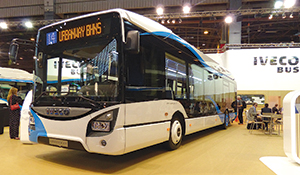
As in North America, European truck and bus manufacturers have spent fortunes developing engines that meet the very latest strict emission limits. Even so, Paris and other large cities in France have said they no longer want diesel powered buses. There is political clamor for hybrid buses and those fueled by compressed natural gas (CNG).
Although hybrid buses use a smaller diesel engine, the French consider it a range extender for hybrid buses to operate in all-electric mode in city centers where air pollution problems can be serious. Earlier this year there were days when pollution in Paris became so serious that motorists were restricted from using their cars and public transport was provided free of charge.
RATP, the major operator of public transport in Paris, awarded contracts in May for the supply of more than 1,000 CNG and hybrid buses through 2017. While the successful bidders are known, RATP still has to decide on the mix of gas and hybrid vehicles for some awards. MAN was told that it had won contracts to supply 200 vehicles to RATP, but the mix between hybrid and gas had not been decided.
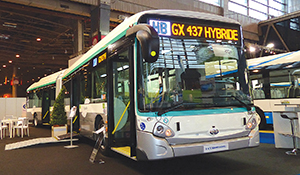
In a previous International Report from France, I mentioned how the name of Case New Holland had appeared discreetly on the Iveco Bus stand as CNH Industrial. In 2011 the Fiat Group split into two divisions for trading on the Milan Stock Exchange. All car operations fell under Fiat Auto; the bus, truck and van manufacturing became part of Fiat Industrial, along with the Case New Holland agricultural and construction machinery business. Fiat Industrial bought out the remaining shareholders in Case New Holland in 2013 and renamed its operations CNH Industrial, trading on the Milan and New York Stock Exchanges.
Iveco Bus has won orders from RATP to supply up to 600 buses, but the mix between gas and hybrid was still to be finalized at the time of the exhibition. One Iveco Bus was its new articulated 60 foot Urbanway, a full low-floor model with a BAE Systems hybrid drive. The rear panel proclaimed the vehicle as Full Hybrid. Though it retains a diesel engine, the vehicle could operate totally in electric mode in city centers — it is therefore politically acceptable.
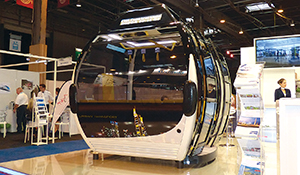
Heuliez Bus, which is 9 percent CNH Industrial owned, announced its confirmed order from RATP for 200 hybrid articulated buses, again with the BAE Systems drive. When all these vehicles are delivered, BAE Systems will sit firmly in the leading position as a hybrid drive supplier to Paris.
During the exhibition, I talked to Pierre Lahutte, CEO of Iveco Bus. The company describes itself as a full-provider, being able to supply every kind of bus or coach from minibuses upwards. Last year, his company took second place in sales of city buses, interurban and luxury coaches in Europe.
We talked about the demand for all-electric buses. The prototype ELLISUP vehicle was going through an intensive test program and is likely to enter demonstration service later in the year. However, Lahutte says his company’s hybrid road map, Arrive & Go, is already available, with a hybrid plug-in to come that will feature fast charging at the end of each route. The next stage beyond that is an electric plug-in for zero carbon emissions locally.

He says Iveco Bus does not believe in an electric vehicle with large and heavy batteries for extended range. He sees the smart solution for the future as an electric plug-in with fast and regular charging.
Iveco has produced gas-powered buses for around 25 years and is Europe’s leader for that technology with nearly 5,000 vehicles in service. The company had secured an order to supply 350 gas buses to Astana, in Kazakhstan, a republic in Central Asia which has rich reserves of gas. Its sister company, Fiat Power Train, delivered 1,400 gas engines to Beijing during 2013.
Politicians in French cities love to put their own stamp on projects. Iveco Bus and some of its competitors offer their standard city buses with the same structure, but with different external panels and higher levels of interior comfort and furnishings. In France these Bus Rapid Transit (BRT) vehicles are known as Bus à Haut Niveau de Service, which can look radically different and even more like a tram. Ideally, they should have their own separate roadways, segregated from other traffic in order to speed up point-to-point journey times. The Iveco BHNS Crealis is available at 40 and 60 feet.
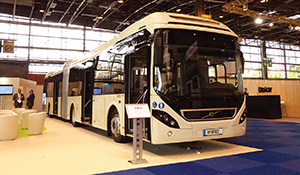
Iveco Bus recently won an order to supply 151 Crealis buses to the city of Baku, Azerbiajn. At the risk of turning this report into a geography lesson, the country lies on the west side of the Caspian Sea, sandwiched between Russia and Iran.
Mercedes-Benz has been incredibly successful with its Citaro city bus range. In the spring, the company handed over its 40,000th unit was handed over to a customer, which must surely make it a record production run in modern times. Probably only Ikarus of Hungary in its prime built more, but that was when it had regular orders for 8,000 per annum from Russia.
At Transports Publics, Mercedes-Benz unveiled the articulated Citaro BRT, which retains the standard structure, but has a restyled front end and additional side windows that let more light in below the waist rail. The wood-like floor makes the vehicle look more like a café than a bus. Other features included charging points for cell phones and four double-width doors to help passengers get on and off quickly at busy stops.
This was also an opportunity to catch up with Van Hool, which showed an 80-foot bi-articulated ExquiCity hybrid bus for a customer in the Duchy of Luxembourg.
Van Hool is steadily building up production of its more standardized, economy-priced coaches at its new factory in Macedonia in southeast Europe. The main plant in Belgium is concentrating on high specification vehicles, including diesel, gas and fuel cell hybrid, all-electric, and high specification coaches, including double-deckers, principally for Stagecoach and its megabus.com operations. Several of the models are so specialized that the larger manufacturers would not dream of building them. Van Hool’s two-factory strategy looks to be inspired.
Two of the largest public utilities in France, Electricite de France and Gaz de France, actively encourage the use of vehicles with alternative fuels by installing the infrastructure for recharging or refueling.
There were several smaller vehicles in the exhibition, all with much of their floor only one step above the ground. They are suited to precinct type services in old city centers with narrow streets, and also as demand-responsive transport for the disabled and the elderly.
In France, there is also a strong industry providing services to bus and coach fleets. Quite a number of these are aimed at improving information for passengers and enabling them to pre-purchase fares remotely. We might rapidly be approaching the time when city buses become cash-free zones, but quite how tourists will be expected to understand different payment systems in foreign languages is another challenge facing the industry.
